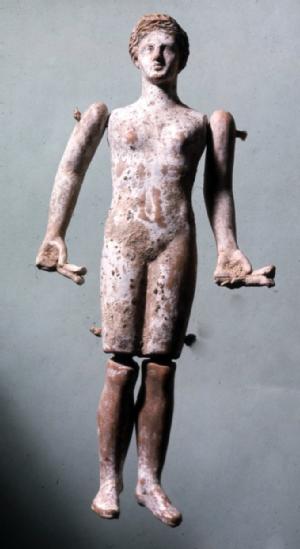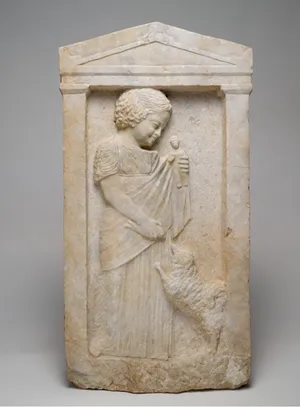Moulding the Maiden in Ancient Greece - Lizz Hayes

Figure 1: Terracotta dancing doll (British Museum, 1865,0720.34). Height: 20.50cm (with legs); weight: 178 grammes; width: 7 cm. Image credit: © The Trustees of the British Museum
THE TOY INDUSTRY: what a booming business. And in the last century, what doll has been more iconic than BarbieTM? Her blue eyes, blonde hair and slim figure are all features which highlighted an idealised version of beauty many idolised and even dreamed of having. But you and I both know, reaching this appearance is more in the hands of nature than ours.
Today, MattelTM (producer of BarbieTM) is the modern equivalent of ancient Greece’s Coroplasts (literally, ‘moulders of maidens’) - the crafters of dolls much like the one above (fig.1). This terracotta figurine was found in Athens, dating from 350BC. It’s in the form of a young dancing woman, her castanets clasped in each hand. Her coiffure is styled with the trends of the day, making her a rather fashionable doll. But she is just one type of so many made over centuries.
What was its purpose?
Simply put, it was originally thought these figurines were wind chimes. Imagine the breeze blowing through the arms and legs, jingling and jangling - it might almost seem as though she is dancing to the sound of her own castanets. An amusing charm. Perhaps this could explain their extensive production number?
But we can’t stop our analysis there. We have important questions to ask - where’s the evidence? And why, like many others, is this doll in the form of a nondescript woman? Delving deeper unveils these dolls tell us more about ancient Greek society and customs than their blank faces let on.
When explored further, scholars believed these dolls could have been offerings dedicated before marriage. They were symbols of a childhood past and the future as a woman, a transition to be marked out. The lyrical poet, Pindar, tells us of instruments like castanets, krotala, used in pre-marriage celebrations of the ‘Great Mother’ (Pindar, Fragments, 70b.9-10, trans. Race 1997) - an apt goddess to worship at this point in a young woman’s life. Castanets, we might reflect, much like the ones held in the hands of our dancing doll (fig.1).
Perhaps more conclusive is the reported case of a doll dedication. Our evidence: an epigram about a young girl named Timareta, who experienced such an event…
‘Timareta, the daughter of Timaretus, before her wedding, hath dedicated to thee, Artemis of the lake, her tambourine and her pretty ball, and the caul that kept up her hair, and her dolls, too, and their dresses; a virgin’s gift, as is fit, to virgin Dian. But, daughter of Leto, hold thy hand over the girl, and purely keep her in purity.’
- Anonymous, The Greek Athnology,280, Trans. Paton 1916
It reveals this girl dedicated her dolls and their dresses to the virgin goddess Diana before her own marriage. Here, Timareta’s doll is a pre-marriage offering.
But let’s trace the cracks in this story…
It’s thought this epigram was inaccurately translated. Timareta did not dedicate her dolls, instead, she gave a much more common offering of hair. Since the translation was revised, it has been generally accepted amongst academics, and we can no longer use this epigram to evidence a doll dedication.
Our second consideration is the depiction of these dolls on graves. On funerary reliefs, it’s not necessarily the dolls’ presence, but the age of the girls who hold them in these reliefs - they are far too young for marriage, even by ancient standards (fig.2). Might this suggest the dolls have a bigger role to play as a representation of a child’s life than their symbolism for a marriageable young woman?
Rather, we could look at these dolls as an expression of family grievance that a young girl should be ‘robbed of the opportunity’ to marry and her inability to then give a dedication. (Newby 2021).
Finally, Timareta’s story is only half-told. This young woman dedicated not only her hair, as we now know it to be, but also a tambourine and ball. Now we ask, why aren’t toys like this portrayed in the same way on graves? Maybe it’s indicative of a deeper concept lying behind these figures, one which was significant enough to be engraved aside the memory of many young girls.

Figure 2: Grave Stele of a Young Girl, “Melisto” (The Harvard Art Museums, 1961.86). Dimensions: 95.5cm hx 49.2 cm w x 10 cm d. Image credit: https://harvardartmuseums.org/collections/object/288045, © President and Fellows of Harvard College
To unpack that thought, we first need to note a recently developed theory for these dolls as votive offerings. In some cases, these offerings were part of a transaction between subject and god, where a recreated body part was extended in return for good health. The posed question here is whether these dolls acted as votive offerings for a heathy puberty? Such a theory gives these figures a highly pressurised meaning, defining a stark contrast between young girl and her doll. The evidence for this idea is rather simplistic. The proof relies on the shape of the figures, namely the small breasts, which are visible on our dancing doll too (fig.1). This bodily feature is emphasised by scholars for its relevance to a girl’s development during puberty, bringing a maturity which would eventually allow her to bear children.
In this situation, dolls reflect the importance ancient Greece laid upon a young girl’s developing body, manifesting this idea in a figurine. To suggest young girls, or indeed a doll, could have any control over the outcome of puberty may seem deluded. But this theory speaks to the idea that dolls could embody damaging messages, much like the dolls of today.
With such significance in a small form, it’s important to ask how children were expected to interact with their dolls?
Plato, a prolific philosopher of his time, believed play acts as a ‘service to the pupils’ (Plato, Laws, VII.819.C, trans. Bury 1926), in which the way children play works as a foundation for their future role in society. If we map this onto the role of a woman in ancient Greek culture, perhaps we could pose these dolls encouraged nurturing tendencies, promoting mothering characteristics from an early age. If these dolls were votive offerings, then this function produced an inflexible pathway for young girls to follow into motherhood.
But this idea wasn’t confined to the ancient world. In fact, you could even reminisce on toy adverts you watched as a child. To give one example, the widely known Baby AnnabellTM doll encourages young girls to nurture a toy baby through feeding, bathing, and putting it to sleep. Does this sound familiar? Does it sound similar?
Dolls as toys…?
Through this discussion, we’ve maintained on some level these dolls had a function as toys. Well, did they? It may sound obvious, but it’s rather proved a problem for historians to evidence. After all, the examples we have, as with our doll (fig.1), are made of fragile materials. Any parent would likely agree, a capricious child and a delicate doll don’t exactly make a match!
Gutschke acknowledged this and poses a theory - a rather tempting one. What if these terracotta dolls are recreations of perishable toys (Gutschke 2019: 220)? Making this even more convincing, we have examples of other toys made from delicate materials too, like a terracotta ball and clay jewellery (Gutschke 2019: 219).
Now, you might ask what’s the point in making these? A possible answer ties together our discussion. Non-perishable objects work well as votive offerings because their symbolism lasts. And yet, their original, perishable form, could be used in play. One form, many functions.
Our problem… perishable toys perish. As appealing as this theory is, there is little evidence to tie the two together.
What’s the final verdict?
Whilst we might not have a definitive conclusion, and may never, there are always studies being done and new theories developed. Ultimately, historians don’t know everything!
However, the current position on the symbolism of these dolls is they encouraged young girls to grow up fitting the idealistic mould of many ancient Greek women: motherhood, household duties, and family responsibilities.
But let’s end on a positive note! We started comparatively with Barbie’sTM image as a blue eyed, blonde haired, slim figured fantasy. But that’s not where we’re at now. Over the years, MattelTM has made BarbieTM more inclusive. 2018 saw the production of the BarbieTM ‘role models’ line, reimagining dolls as inspiring women like Rosa Parks and Frida Kahlo. The aim was to inspire young girls to dream big ambitions and not to be pigeon-holed.
Let’s encourage this message, let’s break the maiden’s mould.
Bibliography
Primary Sources:
Anonymous, The Greek Anthology 6, trans. W.R. Paton (Cambridge Mass: Harvard University Press 1916).
Pindar, Fragments, trans. W.H. Race (Cambridge Mass: Harvard University Press 1997).
Plato, Laws, trans. R.G. Bury (Cambridge Mass: Harvard University Press 1926).
Secondary Sources:
Daux, G. (1973) ‘Anth. Pal. VI 280 (Poupées et Chevelure, Artemis Limnatis)’, Zeitschrift für Papyrologie und Epigraphik, 12: 225-234.
Davidson, G.R., Thompson, D.B., Thompson, H.A. (1943) ‘Small Objects from the Pnyx: I’, Hesperia Supplements 7, 1-172.
Elderkin, K. (2009) Jointed Dolls in Antiquity (Piscataway NJ: Georgias Press).
Golden, M. (2003) ‘Childhood in Ancient Greece’, in Neils, J., and Oakley, J.H. (eds) (2003). Coming of Age in Ancient Greece: Images of Childhood from the Classical Past. London, Yale University Press, 13-31.
Gutschke, F. (2019) ‘Greek Terracotta Dolls: Between the Domestic and the Religious Sphere’, in Papantoniou, G., Michaelides, D., and Dikomitou-Eliadou, M. (eds) (2019). Hellenistic and Roman Terracottas. Leiden, Brill, 215-222.
Hutton, C.A. (1899) Greek Terracotta Statuettes. London, Seeley and Co. Limited.
Lonsdale, S.H. (1952) Dance and ritual play in Greek Religion. London, John Hopkins University Press.
Mattel (n.d.) Barbie: Our History. Last accessed 19/07/21, available at: https://barbie.mattel.com/en-us/about/history.html
Merker, G.S. (2000) ‘The Sanctuary of Demeter and Kore: Terracotta Figurines of Classical, Hellenistic, and Roman Periods’, Corinth 18, iii-374.
Muratov, M.B. (2004) ‘Greek Terracotta Figurines with Articulated Limbs’ Heilbrunn Timeline of Art History Essays. Last accessed 24/06/21, available at: https://www.metmuseum.org/toah/hd/gtal/hd_gtal.htm
Newby, Z. (2021) Treasured Toys or Substitutes for the Dead? Dolls in Roman Tombs. Last Accessed 28/04/22, available at: https://blogs.warwick.ac.uk/materialmusings/entry/treasured_toys_or/
Oakley, J.H. (2003) ‘Death and the Child’, in Neils, J., and Oakley, J.H. (eds) (2003). Coming of Age in Ancient Greece: Images of Childhood from the Classical Past. London, Yale University Press, 163-195.
Reilly, J. (2000) ‘Naked and limbless: learning about the feminine body in ancient Athens’, in Koloski-Ostrow, A.O., and Lyons, C.L. (eds) (2000). Naked truths: women, sexuality, and gender in classical art and archaeology. New York, Routledge, 154-163.
Sommer, M., Sommer, D. (2015) Care, Socialization and play in Ancient Attica: a developmental childhood archaeological approach. Aarhus, Aarhus University Press.
The British Museum (n.d.) doll (1865,0720.34). Last Accessed 24/06/21, available at: https://www.britishmuseum.org/collection/object/G_1865-0720-34
List of Illustrations:
Fig. 1 Terracotta dancing doll (British Museum, 1865,0720.34). Height: 20.50 centimetres (with legs); weight: 178 grammes; width: 7 centimetres. Image credit: © The Trustees of the British Museum https://www.britishmuseum.org/collection/object/G_1865-0720-34 , accessed 24/06/21).
Fig. 2 Grave Stele of a Young Girl, “Melisto” (The Harvard Art Museums, 1961.86). Dimensions: 95.5cm hx 49.2 cm w x 10 cm d. Image credit: © President and Fellows of Harvard College https://harvardartmuseums.org/collections/object/288045, accessed 8/07/21).
